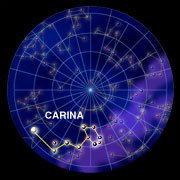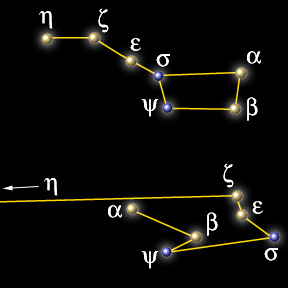Eridanus is best seen from November through February.
Click on image for full size
Windows to the Universe original image
Eridanus
Eridanus is known as the Celestial River. It most often related to the Nile or Euphrates Rivers because they were so important to ancient civilizations. Eridanus is the second longest constellation in the night sky.
The brightest star is called Achernar. This star is at the southern end of the constellation, and is rarely seen in the Northern Hemisphere. The other tip is held by Cursa. It sets next to the bright star Rigel in the constellation Orion.
With some difficulty Eridanus can be traced through the sky. Once you find Cursa, follow the stars east and south. Most of the Northern Hemisphere can only see the top half of this long figure. Those living below the Equator can continue through the strands of lights until they reach Achernar.
There are over three dozen faint galaxies within Eridanus.
You might also be interested in:

What's in a Name: Arabic for "foot" Claim to Fame: One of the galaxy's brightest stars. Apparent visual magnitude = 0.1 Type of Star: Brilliant bluish-white Supergiant (B8 1a Spectral Type) How Far Away:
...more
Many different constellations fill the evening sky in the northern hemisphere. Depending on your location and the season, different constellations can be seen. Northern circumpolar constellations can be
...more
Many different constellations fill the evening sky in the southern hemisphere. Depending on your location and the season, different constellations can be seen. Southern circumpolar constellations can be
...more
The constellation Carina is known as the Keel, which is the bottom part of old ships. Carina was originally a part of Argo Navis, which was a huge boat in the night sky. It has since been divided into
...more
In most cases, however, the stars that we see that seem to be "close" to each other actually are quite far apart, some stars are much closer or farther than others as is shown in the example below of Ursa
...more
In our time, scientists (and most people!) know that the constellations seem to move across the sky because the earth rotates on its axis. What, you may ask, does the turning of the earth have to do with
...more
If you look at the night sky different times of the year you see different constellations. This change is due to the motion of the Earth in its orbit around the Sun. Each day a few stars are visible in
...more
Constellations are formed of bright stars which appear close to each other on the sky, but are really far apart in space. The shapes you see all depend on your point of view. Many societies saw patterns
...more














